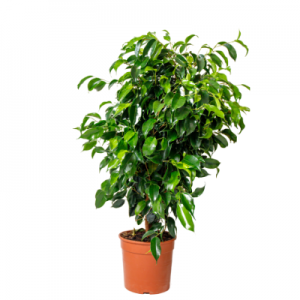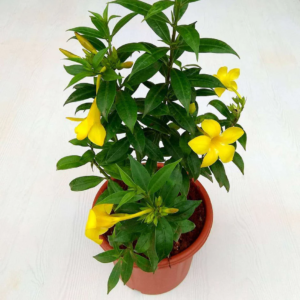Description
The Black Ficus Plant: An Enigmatic Jewel of Indoor Greenery
Among the many marvels of the plant world, the Black Ficus stands as a striking anomaly—a dark, elegant, and mysterious presence in any space it inhabits. Its inky foliage, architectural form, and subtle luster set it apart from the traditional lush greenery of typical indoor plants. The Black Ficus is not a naturally occurring species per se, but rather a cultivated variety or rare mutation of the well-known Ficus elastica, commonly referred to as the Rubber Plant. Its deeper-hued leaves have led it to be affectionately dubbed the “Black Ficus”, though it often appears in botanical circles under names like Ficus elastica ‘Burgundy’ or Ficus elastica ‘Black Prince’.
Botanical Background
Belonging to the Moraceae family, Ficus elastica originates from the tropical forests of Southeast Asia, particularly India, Nepal, Bhutan, and Indonesia. These regions are rich in biodiversity, and the Ficus species plays an integral role in forest ecosystems—providing food and habitat to wildlife, particularly fig wasps, which are involved in their intricate pollination process.
The Black Ficus is a cultivated variant selected for its deeply pigmented leaves, which can range from rich burgundy to near-black depending on light conditions. While it shares most growth characteristics with its green-leafed relatives, its visual allure is distinctly more dramatic.
Aesthetic Appeal
What makes the Black Ficus so desirable is its moody and elegant palette. The leaves are thick, glossy, and leathery, with a velvety sheen that seems to absorb light rather than reflect it. New growth often emerges as a reddish hue, unfurling with copper or maroon undertones before maturing into a near-black finish. Each leaf is ovate, with a prominent central vein and smooth margins, and can grow up to 12 inches long under ideal conditions.
The contrast between the dark foliage and the often reddish petioles (leaf stems) adds a layer of visual complexity. In brightly lit rooms with white or minimalist decor, the Black Ficus becomes a centerpiece—its silhouette bold and sculptural. In dimmer, mood-lit environments, it takes on a more gothic or mysterious character, blending into shadows like a living piece of art.
Symbolism and Cultural Significance
In various cultures, the Ficus tree has deep symbolic meaning. In India, the Ficus religiosa (a close relative) is revered as the sacred Bodhi tree, under which the Buddha is said to have attained enlightenment. Although the Black Ficus is not used in religious rituals, its association with strength, endurance, and wisdom still resonates symbolically. Its resilience and adaptability to indoor life have also made it a symbol of domestic prosperity and balance.
The color black, especially in botanical forms, is often linked to mystery, power, and sophistication. Thus, the Black Ficus is not just a plant, but an emblem of contemporary aesthetics, merging the natural with the avant-garde.
Care and Maintenance
One of the most appealing aspects of the Black Ficus is its low-maintenance nature, making it an excellent choice for both novice and experienced plant keepers.
Light Requirements
The plant thrives in bright, indirect light, though it can tolerate moderate levels. However, the richness of its foliage is most vivid when it receives ample diffused sunlight. Direct sunlight may cause leaf burn, while low light can cause leggy growth and dull coloration.
Watering
Watering should be done only when the top inch of soil feels dry. The Black Ficus dislikes “wet feet,” so well-draining soil is essential. Overwatering can lead to root rot, one of the few common issues with this otherwise hardy plant. In winter, reduce watering frequency as growth naturally slows.
Humidity and Temperature
Being a tropical plant, the Black Ficus appreciates moderate to high humidity and stable temperatures between 60–85°F (15–29°C). Sudden temperature drops or drafts can cause stress, leading to leaf drop.
Fertilization
During the growing season (spring and summer), a balanced liquid fertilizer once a month helps maintain vibrant foliage and supports new growth. In fall and winter, fertilizing is not typically necessary.
Pruning and Repotting
The plant can grow several feet tall indoors but can be pruned to maintain a compact shape. Regular pruning also encourages bushier growth. Repotting every two years or when roots begin to outgrow the pot ensures continued health.
Pests and Problems
While relatively pest-resistant, the Black Ficus can occasionally suffer from common indoor plant pests like mealybugs, spider mites, and scale insects. These are best dealt with using neem oil or insecticidal soap. Yellowing or falling leaves are often signs of overwatering, low light, or stress from relocation.
Another quirk of the Ficus family is their sensitivity to change. Moving the plant to a new location or changing conditions abruptly can result in temporary leaf drop—a natural response that usually stabilizes once the plant acclimates.
Environmental Impact and Sustainability
The Black Ficus, like many houseplants, plays a role in improving indoor air quality. It has been cited in NASA’s Clean Air Study for its ability to filter out toxins such as formaldehyde, benzene, and trichloroethylene from the air, making it not just beautiful but also beneficial to health.
From a sustainability standpoint, sourcing plants from ethical growers is vital. Look for nurseries that practice organic farming and support local biodiversity to ensure that your green decor is as eco-conscious as it is elegant.
Design Integration
Interior designers frequently incorporate the Black Ficus into spaces that call for bold contrast, minimalism, or modern luxury. Its upright form makes it ideal for corners, hallways, or next to furniture pieces that need vertical balance. It pairs beautifully with gold accents, matte blacks, and natural wood tones. In office spaces, it conveys professionalism and refinement without appearing too sterile.
For smaller dwellings, compact cultivars or trimmed versions are available, offering all the drama in a scaled-down size. Some design enthusiasts even experiment with bonsai versions, turning the Black Ficus into a miniature living sculpture.
Conclusion
The Black Ficus plant is more than just a trendy houseplant—it’s a statement of style, a nod to nature’s darker palette, and a living sculpture that evolves with time and care. With its alluring appearance, symbolic richness, and ease of care, it offers both aesthetic pleasure and botanical fascination. Whether placed in a sunlit living room, a moody study, or a curated workspace, the Black Ficus commands attention—silently but unmistakably.







Reviews
There are no reviews yet.